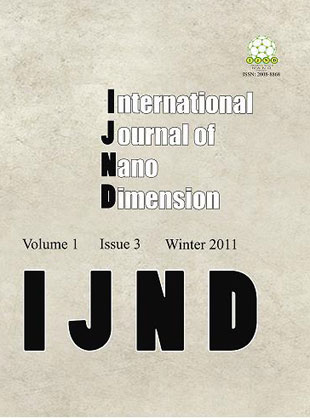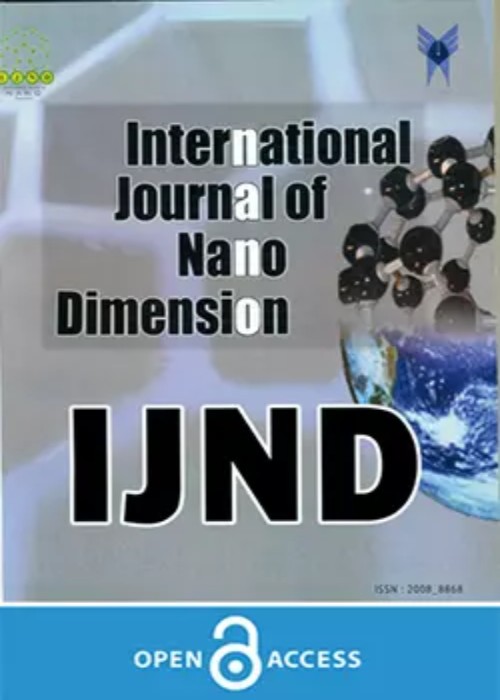فهرست مطالب

International Journal of Nano Dimension
Volume:1 Issue: 3, Winter 2011
- تاریخ انتشار: 1389/12/05
- تعداد عناوین: 8
-
Page 159The Scanning Probe Microscopes (SPMs) based lithographic techniques have been demonstrated as an extremely capable patterning tool. Manipulating surfaces, creating atomic assembly, fabricating chemical patterns, imaging topography and characterizing various mechanical properties of materials in nanometer regime are enabled by this technique. In this paper, a qualified overview of diverse lithographical methods mostly based on making nano-structures is presented.
-
Page 177Nanocrystalline alumina powder has been synthesized using solution combustion method. The obtained nanocrystalline alumina powder was used as an efficient catalyst for the synthesis of imidazo[1,2-a]azine derivatives from one-pot three component reaction of benzaldehyde, 2-aminoazine and trimethylsilylcyanide under ultrasonic irradiation and refluxing condition. Reusability of catalyst and short reaction time as well as high yields are the advantages of this procedure.
-
Page 187An efficient dispersive liquid-liquid microextraction using tetraalkylammonium bromide coated silver nanoparticles (DLLME-AgNPs) prepared in chloroform has been successfully applied as electrostatic affinity probes to the microextraction and preconcentration of terazosin prior to spectrofluorimetry analysis. This technique is based on a ternary system of solvents, where appropriate amount of microextraction containing tetraalkylammonium bromide coated silver nanoparticles (AgNPs), and disperser solvents are directly injected into an aqueous solution containing terazosin. A cloudy mixture is formed, and terazosin in the aqueous matrix is extracted into the fine droplets of microextraction solvent containing AgNPs. The settled phase is collected and transferred into a micro-cell of fluorimeter for the determination of terazosin at excitation/emission wavelengths of 330/376 nm. The obtained results demonstrated that electrostatic attraction forces caused by AgNPs were much stronger than the hydrophobic attraction forces. Various factors influencing microextraction efficiency were studied and optimized. Under the optimum conditions, the method provided a relatively broad linear dynamic range of 0.25 to 100 mg mL−1, a detection limit of 0.075 mg mL−1 and a relative standard deviation of 1.9%. Finally, the method was successfully applied to terazosin determination in actual pharmaceutical formulations and human urine sample.
-
Page 203The interaction between some heavy metal ions such as of Pb(II), Cd(II) and Cu(II) ions from aqueous solution adsorbed by single walled carbon nanotube (SWCNTs) and carboxylate group functionalized single walled carbon nanotube (SWCNT-COOH) surfaces were studied by atomic absorption spectroscopy. The effect of contact time, pH, initial concentration of ion, ionic strength and temperature on the adsorption of ion were investigated. The results indicated that Langmuir model fits adsorption isotherm data better than the Freundlich model. The results also demonstrated that SWCNT-COOH surfaces can more effectively adsorb mentioned ions than a SWCNTs surface. Maximum adsorption capacities (qm) for Pb(II), Cu(II) and Cd(II) ions onto SWCNT-COOH were obtained as 96.02, 77.00 and 55.89 mg/g, respectively and by SWCNTs, as 33.55, 24.29 and 24.07 mg/g, respectively. Thermodynamic parameters values showed that the adsorption of ions on SWCNT-COOH and SWCNTs at 283-313 K is spontaneous and endothermic.
-
Page 221Sol–gel auto-combustion is a unique combination of the combustion and the chemical gelation processes. In this work, nanosize (d) powders with compositions of ZnFe2O4 were synthesized by sol–gel combustion method. The puffy, porous brown powders as-combusted was calcined at the temperature of 750–1000◦C for 4 h. These powders are characterized by X-ray diffraction and scanning electron microscopy. Particle size and morphology of nanocrystalline were determined by XRD and SEM, respectively. The average particle size was estimated about 17 nm for calcined powders. Surface area for zinc ferrite synthesized by this method is 36 m2/g.
-
Page 225Nano dithiocarbamate (DTC) complex have been prepared by reaction between dithiocarbamate and metal salt under ultrasound irradiation. Reaction conditions such as the ligand DTC and phennantroline concentration, aging time and the ultrasonic device power show important roles in the size, morphology and growth process of the final products. The dithiocarbamate complex nanoparticles have been prepared by water solvent. The ultrasonic treatment applied for preparation nanoparticles. The antibacterial activity of nanoparticles derivatives tested against microorganism and compared with non-nano conditions. The resulting nanoparticles were characterized by X-ray diffraction (XRD) and scanning electron microscopy (SEM)
-
Page 233In this study, we investigated the antifungal effects of silver nanoparticles (Ag-Nps) on Candida albicans (ATCC 5027), Saccharomyces cerevisiae (ATCC 5027). Investigating method by using Minimum Inhibitory Concentration (MIC) technique, some of drugs including Amphotericin B, Fluconazole and synthesized Ag-Nps have been obtained on the fungi and the changes on membrane reactions of yeasts have been elucidated by Scanning Electron Microscopy (SEM). The present study indicates Ag-Nps has considerable antifungal activity comparison with other antifungal drugs, so deserving further investigation for clinical applications.
-
Page 241Tissue engineering is defined as the designing and engineering of structures to rebuild and repair a body damaged tissue. Scaffolding Poly Hydroxy Butyrate Valraty (PHBV) has shown good biocompatibility and biodegradable properties. Nanofibers have improved the performance of biomaterials, and could be considered effective. One of the important methods for designing nanofiber scaffold is the electrospinnig method. In this study, PHBV nanofibers were well designed; then, modified with the immobilized collagen via the chemical method. The samples were evaluated by ATR-FTIR, SEM, contact angle and finally, cell culture. ATR-FTIR structural analysis showed the presence of collagen on the nanofiber surfaces. The SEM images showed the size average of nanofibers as to be about 280 nm; that increased with a collagen coating up to 400 nm. Contact angle analysis showed 67 degree for uncoated nanofibers and 52 degree for coated nanofibers. Cellular investigations (USS cells) showed better adhesion and cell growth and proliferation of coated samples than uncoated samples.


